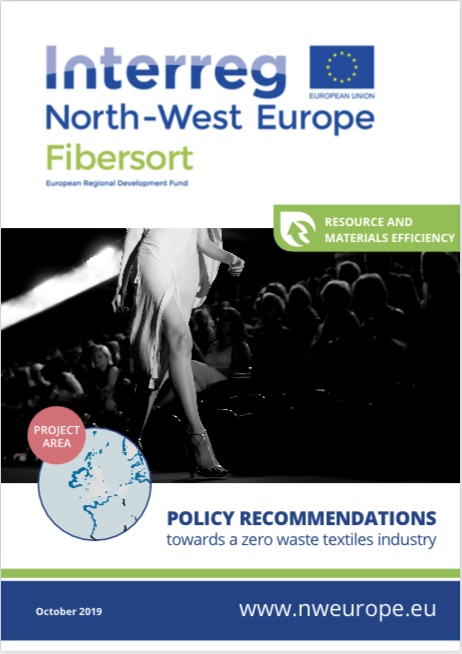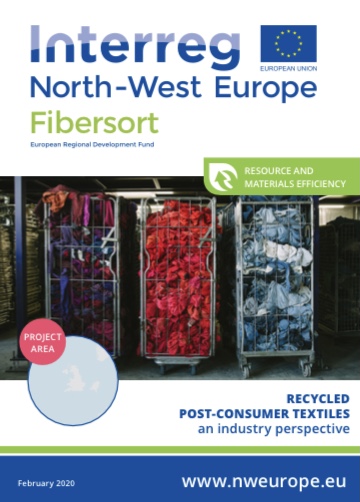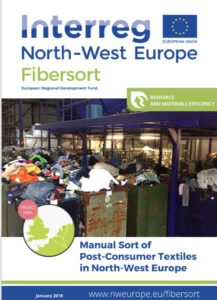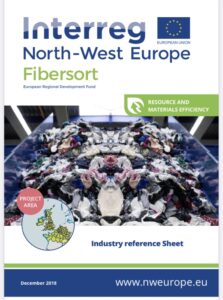Recommendations towards a zero waste textiles industry
In Europe we are facing a growing mountain of used textiles. Latest research shows that in North-West Europe (NWE) 4700 kilo tonnes of post-consumer textile waste (PCT) is generated annually. While the European, national and regional governments have expressed their ambitions to transition to a circular economy for textiles, the reality is that less than 1 per cent of textiles collected are currently recycled into new ones, and around half of them are being down-cycled, incinerated or landfilled. Automated sorting technologies could enable the industry to turn non-rewearable textiles that currently have no other destination than down-cycling, landfill or incineration into valuable feedstock for high-value recycling. One of these technologies is Fibersort, a Near Infrared (NIR) based technology able to categorize textiles based on their fiber composition, structure and colour. In May 2019, the Fibersort Interreg NWE project published an overview of these potential barriers for the implementation of Fibersort technology for collectors and sorters. Within this report, policy recommendations are formulated showing the instruments that regional, national and the European governments have at their disposal to allow Fibersort to live up its full potential.
While currently post-consumer textiles are struggling to successfully find textile-to-textile recycling end-markets, this report explores existing and potential end-markets for PCT, sorted according to their characteristics, and assesses the potential of different business models for brands and manufacturers to successfully integrate the recycled textiles. The research builds on publicly available data of recyclers, manufacturers and brands, as well as primary insights gathered through a survey, interviews with recyclers, manufacturers and brands, as well as industry and academic experts. At the end of each chapter, recommendations are formulated for recyclers, manufacturers and brands to address the barriers for uptake of sorted textiles identified throughout this project:
∙ Making recycled the new norm: exploring socio-cultural barriers
∙ Creating new materials from post-consumer textiles: overcoming physical barriers
∙ Making recycling a sound business choice: reducing economic barriers
The Fibersort team completed a manual sorting exercise to catalogue the contents of 5,000 kg of post-consumer textiles in September of 2017. The aim was to collect data on Fibersort input materials in order to refine the business case for a fibersorting facility. The team found approximately 64% of the items sorted in this study were rewearable and 36% were a combination of non-rewearable items, bedding and waste. Out of all of the materials that were evaluated, an estimated 22% were recyclable. Keeping in mind the reported range of rewearable items fluctuates from 40-89%, it is estimated this rewearable figure is a reasonably realistic reflection of post-consumer textiles across North-West Europe. Within the 36% of textiles that were deemed non-rewearable, nearly two-thirds were composed of either pure fiber blends or two fiber blends, making them candidates for potential textile to textile recycling. The remaining one-third was composed of three or more fiber blends, waste, non-rewearable items constructed from multiple textiles, bedding and non-rewearable shoes. Another benefit of this study is that it begins to illuminate some of the lesser known aspects of post-consumer textiles for brands and retailers. While it was found that within the non-rewearables sorted there were more pure fiber items than blends, it is helpful to understand how fiber composition impacts potential recyclability of a textile. Elastane was present in nearly one out of every five non-rewearable single material items sorted. These are interesting considerations for brands and retailers as they consider how to shift their design and product creation decisions toward circularity.
The Fibersort is a technology that automatically sorts large volumes of garments and finished textile products by fibercomposition. Once sorted, these materials become reliable, consistent input materials for high-value textile-to-textile recyclers. Once commercialized, it will create a tipping point for a new, circular textile industry.
This Industry Reference Sheet provides an overview of post-consumer textile material availability in North-West Europe, as well as suggested grades for textile-to-textile recycling feedstocks, their related price ranges and material certification expectations for collectors/sorters and recyclers. The purpose of this document is to provide collector/sorters, municipalities and recyclers with the information needed to understand the importance, fit and potential for the Fibersort technology.




